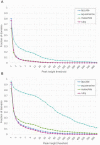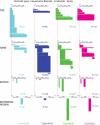Polytene Chromosomes - A Portrait of Functional Organization of the Drosophila Genome
- PMID: 29606905
- PMCID: PMC5850506
- DOI: 10.2174/1389202918666171016123830
Polytene Chromosomes - A Portrait of Functional Organization of the Drosophila Genome
Abstract
This mini-review is devoted to the problem genetic meaning of main polytene chromosome structures - bands and interbands. Generally, densely packed chromatin forms black bands, moderately condensed regions form grey loose bands, whereas decondensed regions of the genome appear as interbands. Recent progress in the annotation of the Drosophila genome and epigenome has made it possible to compare the banding pattern and the structural organization of genes, as well as their activity. This was greatly aided by our ability to establish the borders of bands and interbands on the physical map, which allowed to perform comprehensive side-by-side comparisons of cytology, genetic and epigenetic maps and to uncover the association between the morphological structures and the functional domains of the genome. These studies largely conclude that interbands 5'-ends of housekeeping genes that are active across all cell types. Interbands are enriched with proteins involved in transcription and nucleosome remodeling, as well as with active histone modifications. Notably, most of the replication origins map to interband regions. As for grey loose bands adjacent to interbands, they typically host the bodies of house-keeping genes. Thus, the bipartite structure composed of an interband and an adjacent grey band functions as a standalone genetic unit. Finally, black bands harbor tissue-specific genes with narrow temporal and tissue expression profiles. Thus, the uniform and permanent activity of interbands combined with the inactivity of genes in bands forms the basis of the universal banding pattern observed in various Drosophila tissues.
Keywords: Bands and interbands; Drosophila; Genes; Origin recognition complexes; P-elements; Polytene chromosomes; Promoters; Proteins of open chromatin.
Figures






Similar articles
-
Genetic organization of interphase chromosome bands and interbands in Drosophila melanogaster.PLoS One. 2014 Jul 29;9(7):e101631. doi: 10.1371/journal.pone.0101631. eCollection 2014. PLoS One. 2014. PMID: 25072930 Free PMC article.
-
[Chromomeric organization of interphase chromosomes in Drosophila melanogaster].Tsitologiia. 2013;55(3):144-7. Tsitologiia. 2013. PMID: 23795454 Review. Russian.
-
Drosophila polytene chromosome bands formed by gene introns.Dokl Biochem Biophys. 2016;466:57-60. doi: 10.1134/S1607672916010178. Epub 2016 Mar 31. Dokl Biochem Biophys. 2016. PMID: 27025489
-
Molecular and genetic organization of bands and interbands in the dot chromosome of Drosophila melanogaster.Chromosoma. 2019 Jun;128(2):97-117. doi: 10.1007/s00412-019-00703-x. Epub 2019 Apr 30. Chromosoma. 2019. PMID: 31041520 Free PMC article.
-
Banding patterns in Drosophila melanogaster polytene chromosomes correlate with DNA-binding protein occupancy.Bioessays. 2012 Jun;34(6):498-508. doi: 10.1002/bies.201100142. Epub 2012 Mar 15. Bioessays. 2012. PMID: 22419120 Review.
Cited by
-
Faint gray bands in Drosophila melanogaster polytene chromosomes are formed by coding sequences of housekeeping genes.Chromosoma. 2020 Mar;129(1):25-44. doi: 10.1007/s00412-019-00728-2. Epub 2019 Dec 9. Chromosoma. 2020. PMID: 31820086
-
A proposed unified interphase nucleus chromosome structure: Preliminary preponderance of evidence.Proc Natl Acad Sci U S A. 2022 Jun 28;119(26):e2119101119. doi: 10.1073/pnas.2119101119. Epub 2022 Jun 24. Proc Natl Acad Sci U S A. 2022. PMID: 35749363 Free PMC article.
-
The dance of proteostasis and metabolism: Unveiling the caloristatic controlling switch.Cell Stress Chaperones. 2024 Feb;29(1):175-200. doi: 10.1016/j.cstres.2024.02.002. Epub 2024 Feb 6. Cell Stress Chaperones. 2024. PMID: 38331164 Free PMC article. Review.
-
Human EWS-FLI protein recapitulates in Drosophila the neomorphic functions that induce Ewing sarcoma tumorigenesis.PNAS Nexus. 2022 Oct 6;1(4):pgac222. doi: 10.1093/pnasnexus/pgac222. eCollection 2022 Sep. PNAS Nexus. 2022. PMID: 36714878 Free PMC article.
-
Chromatin Organization and Function in Drosophila.Cells. 2021 Sep 8;10(9):2362. doi: 10.3390/cells10092362. Cells. 2021. PMID: 34572010 Free PMC article. Review.
References
-
- Painter T.S. Salivary chromosomes and the attack on the gene. 1934 demic.oup.com/jhered/article-abstract/25/12/465/807076? redirectedFrom=f...
-
- Koltzoff N.K. The structure of the chromosomes in the salivary glands of Drosophila. Science. 1934;80(2075):312–313. science.sciencemag.org/content/80/2075/312 - PubMed
-
- Bridges C.B. Salivary chromosome maps with a key to the banding of the chromosomes of Drosophila melanogaster. J. Hered. 1935;26(2):60–64.
-
- Zhimulev I.F., Zykova T.Y., Goncharov F.P., Khoroshko V.A., Demakova O.V., Semeshin V.F., Pokholkova G.V., Boldyreva L.V., Demidova D.S., Babenko V.N., Demakov S.A., Belyaeva E.S. Genetic organization of polytene chromosome bands and interbands in Drosophila melanogaster. PLoS One. 2014;9(7):e101631. journals.plos.org/plosone/article? id=10.1371/journal.pone.0101631 - PMC - PubMed
-
- Vatolina T.Y., Boldyreva L.V., Demakova O.V., Demakov S.A., Kokoza E.B., Semeshin V.F., Babenko V.N., Goncharov F.P., Belyaeva E.S., Zhimulev I.F. Identical functional organization of nonpolytene and polytene chromosomes in Drosophila melanogaster. PLoS One. 2011;6(10):e25960. journals.plos.org/plosone/article?id=10.1371/journal.pone.0025960 - PMC - PubMed
Publication types
LinkOut - more resources
Full Text Sources
Other Literature Sources
Molecular Biology Databases
Research Materials
